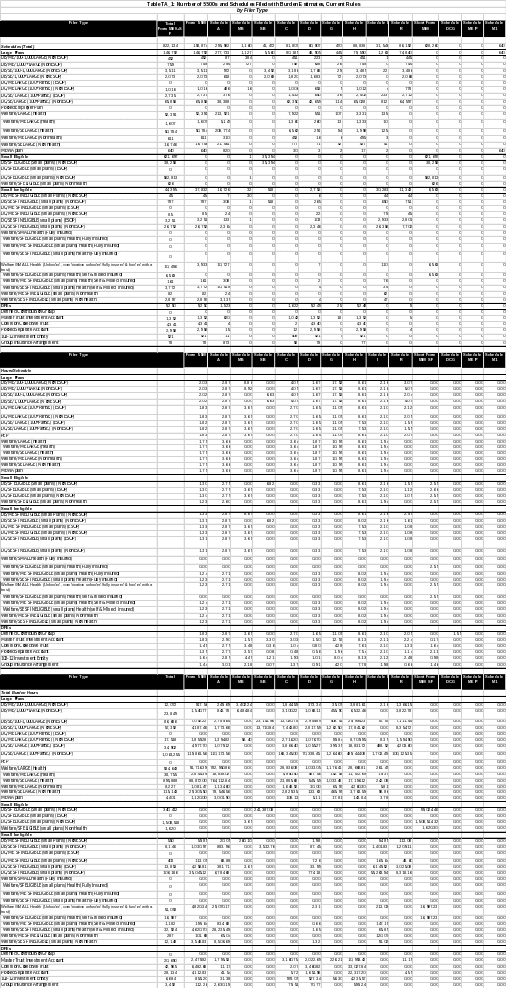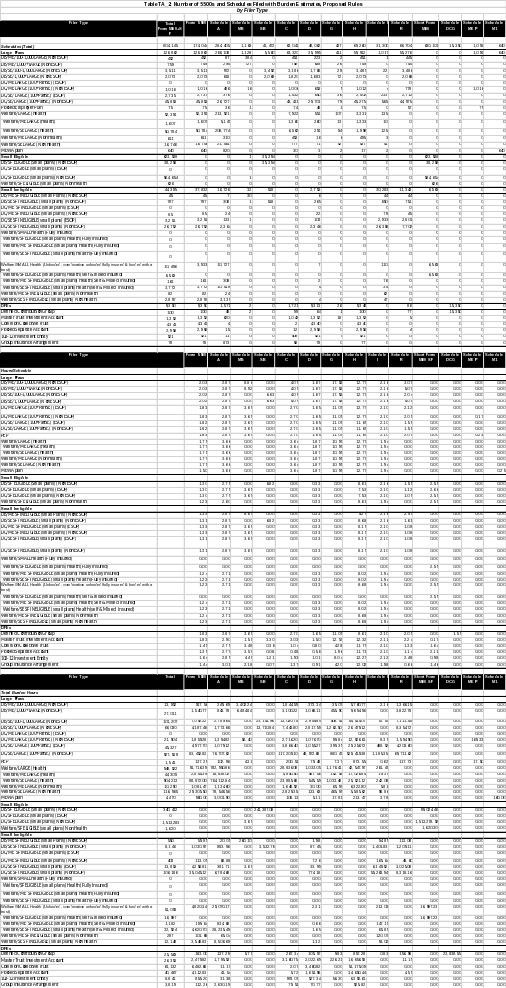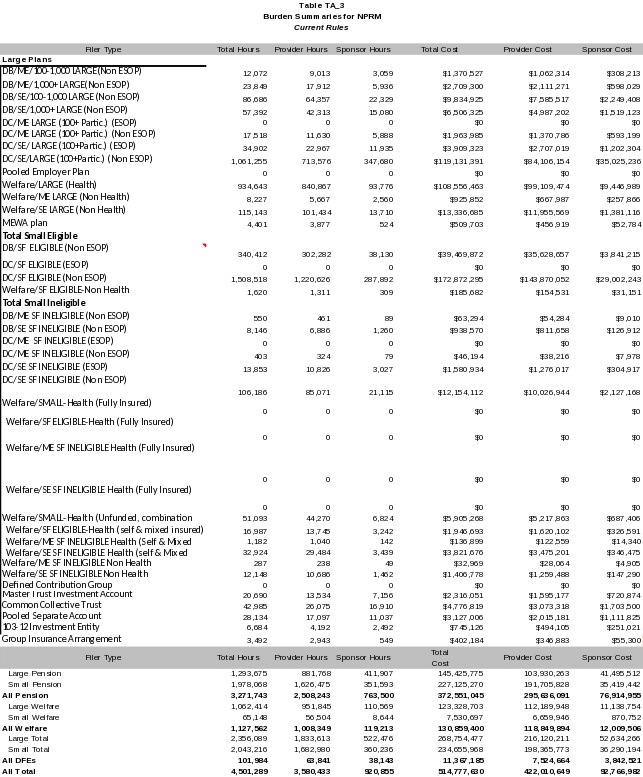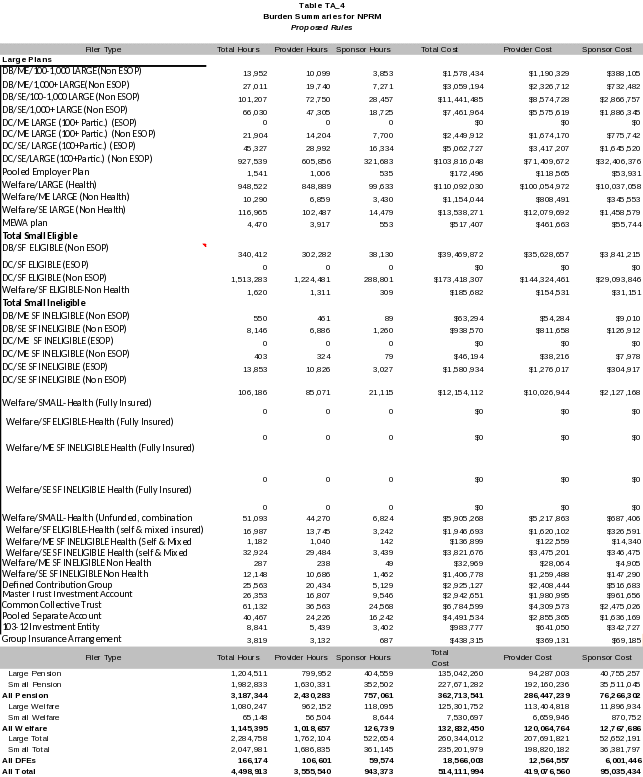2022 5500 Technical Appendix
2022 5500 Technical Appendix.docx
Annual Information Return/Report
2022 5500 Technical Appendix
OMB: 1212-0057
Technical Appendix: Documentation of the Burden Estimates Used to Calculate the Burden Associated with the Proposed Rule
August 2021
Overview
This technical appendix details the types of entities and their correspondent burden changes that were considered to estimate the economic impacts of the proposed rules and form revisions for the Form 5500 and its schedules, instructions, and attachments. This appendix provides a general overview of the estimation process and outputs. The results of estimated economic impacts are reported at the end of the appendix.
For this revision of the Form 5500 annual return/report, the Department of Labor (DOL) used its knowledge and experience to factor in varying levels of complexity with respect to the burden estimate for various items. By taking the complexity of the changes into account, rather than merely counting the number of items added or deleted, the burden model can more accurately reflect the economic impacts of proposed rules. With the exception of this change, however, the burden calculation methodology for the present proposed changes remains similar to previous calculation methodologies.
Calculating the burden included the following steps. First, the DOL created a baseline by estimating the burden under current rules. Second, the DOL identified schedules and types of filers that would be affected by the revisions and adjusted the burden hour counts and the filer counts in each schedule accordingly. Finally, the DOL estimated economic burdens under proposed rules by multiplying the adjusted burden of hour counts by the affected filer counts.
Input to the Burden Model
Baseline Schedule Counts
The baseline schedule counts rely on the number of plans currently filing the Form 5500 or the Form 5500-SF. These plan counts are queried from the DOL’s EFAST2 filing system. Schedule counts for the baseline rules reflect “best filings” from the 2018 Form 5500 filings, the most recent year available. Some filers are eligible to file the Form 5500-SF, but choose to file a Form 5500 and attach Schedule I and/or other schedules because they find it less burdensome to do so in their particular situation. In an effort to be conservative in estimating burden, counts of these filings are adjusted to reflect what they would have filed if they had chosen to file the Form 5500-SF.
Baseline Burden Hours per Schedule
Baseline burden hours are the average hours needed to fill out each schedule including the Form 5500 and the Form 5500-SF by plan type. Plan type is categorized by size—Large (generally 100 participants or more) or Small (generally fewer than 100 participants). Then plan type is categorized as either Pension plan (Defined Benefit or Defined Contribution) or Welfare plan (non-Health or Health).
Fractions of Burden per Agency and per Entity by Schedule
The baseline fractions of burden per agency are the shares across agencies (DOL, the Internal Revenue Service (IRS), and the Pension Benefit Guaranty Corporation (PBGC)) from the revisions to the Form 5500 Annual Return/Report, as finalized. These baseline fractions are further broken down to burden by type of entity (service provider to plan or plan sponsor v. plan sponsor or plan).
Form and Schedule Counts after Revisions
Schedule counts for the revisions are adjusted to closely reflect the nature of proposed rules. For instance, a number of Form 5500 filers have been removed and added to Form 5500-SF filersto take into account the estimated number of plans that would be impacted by the proposed rule changing the current method of counting participants for purposes of determining when a defined contribution plan may file as a small plan. In addition, proposed Schedule MEP (Multiple-Employer Retirement Plan Information) and proposed Schedule DCG (Individual Plan Information for Defined Contribution Groups)would be new schedules to the Form 5500 Annual Return/Report, but for most filers generally would ask for information that is already required to be reported..
Burden Hours per Schedule after Revisions
To gauge the extent to which burden hours are increased or decreased after revisions, the DOL’s economists carefully reviewed revised items and consulted with the DOL’s regulatory and accounting staff in EBSA’s Office of Regulations and Interpretations and Office of the Chief Accountant. These staff have many years of experience advising the public on how to file the Form 5500 and some had filed Form 5500 as part of prior private sector work experience. In the case of the Schedule MEP the burden was estimated considering the new format in reporting existing information. In the case of the Schedule DCG the burden from Schedule 5500-SF was used as reference.
Fractions of Burden per Agency and per Entity by Schedule after Revisions
For forms and schedules already in existence, few changes were made to the assignment of burden across agencies and entities (service provider vs. plan sponsor). Schedule MEP was assigned only to the DOL and IRS in equal shares, and for its burden assignment across service providers and plan sponsors the current assignment of the Form 5500 was used. Schedule DCG was assigned only to the DOL and IRS, and for all the burden assignment across agencies, and across service providers and plan sponsors, the current burden assignments of Form 5500-SF were used.
Labor Costs
To estimate cost changes in real dollar terms, the DOL applied an hourly labor cost rate of $100.74 per hour to sponsors in the baseline year and also after revisions to reflect the cost of work performed “in-house.” For a description of the DOL’s methodology for calculating wage rates, see https://www.dol.gov/sites/dolgov/files/EBSA/laws-and-regulations/rules-and-regulations/technical-appendices/labor-cost-inputs-used-in-ebsa-opr-ria-and-pra-burden-calculations-june-2019.pdf. The DOL applied an hourly cost rate of $117.87 per hour to service providers in the baseline year and also after revisions. This rate reflects a 17 percent premium on the cost of performing work “in-house” to include profits and administrative costs that would be included in a service provider’s bill to a plan for performing the work. This rate is consistent with the DOL’s review of publicly available data on profit margins and hourly billing rates in the accounting industry.1
To estimate the economic impacts of the proposed rule, we first aggregate the baseline burden hours per schedule by multiplying plan counts by burden hours for each schedule. The aggregated total burden hours are estimated by size, type and by entity (service provider v. plan sponsor). Then total costs per entity are estimated by multiplying total burden hours of each entity by respective wage rates. Next, we aggregate the total burden hours per schedule under the proposed rules by multiplying projected plan counts by projected burden hours for each schedule. Then these burden hours are converted to total costs by multiplying the aggregate total hours per schedule and per entity by respective wage rates of each entity. The difference between the total costs under the proposed rules and under the current rules are the economic impacts of the revisions.
The tables at the end report show each step described above. Total burden hours per schedule and entity under current and proposed rules are summarized in Tables TA_1 and TA_2 respectively. Tables TA_3 and TA_4 present total costs per entity under current rules and under proposed rules.
The following list summarizes significant changes and their implications on the economic burden.
Schedule MEP and Pooled Employer Plans
Under the proposal, the new Schedule MEP is created and is to be filed by all MEPs, including pooled employer plans.
Number of Affected Filers
Data estimates are available for MEPs that have filed a Form 5500 previously, but not for the newly created pooled employer plans that have yet to file a Form 5500. The DOL assumes there would be a total of 75 pooled employer plans. The DOL estimates that a total of 2,251 small participating plans and 563 large participating plans would provide benefits through pooled employer plans. The DOL does not have information on how many Professional Employer Organizations meet the conditions to sponsor defined contribution MEPs nor how many Association Retirement Plans currently exist.
Change in Burden Hours
The burden to file the Schedule MEP is estimated to average 10 minutes for MEPs and 14 minutes for pooled employer plans.
Introduction of DCGs and Schedule DCG filing
Defined Contribution Groups would be able to file a consolidated Form 5500 as an alternative method of compliance for defined contribution pension plans that participate in DCG reporting arrangements. Each DCG would have to file a Schedule DCG per individual plan to report plan-level information.
Number of Affected Filers
The DOL estimates that there would be 100 DCGs filing on behalf of a total of 15,350 small plans under this new arrangement.
Change in Burden Hours
Small plans under this new arrangement would not have to file the Form 5500-SF any longer. For the burden of completing a schedule DCG, as part of the DCG’s Form 5500 annual return/report, the DOL estimates that this would take about 40 percent less time than completing a Form 5500-SF for each individual plan.
The proposal contains a revision to the Schedule H, Line 4i Schedules of Assets, which further breaks out (i) assets held for investment and (ii) assets disposed of during plan year.
Number of Affected Filers
The affected filers are the filers of Schedule H.
Change in Burden Hours
For the plans filing Schedule H burden hours are estimated after reviewing revisions and consulting with DOL experts.
Changes to Methodology for Determining Small Plan Status for Annual Report Filing
This proposal would change the current method of counting participants for purposes of determining when a defined contribution plan may file as a small plan and whether the plan may be exempt from the IQPA audit requirement.
Number of Affected Filers
There are an estimated 19,442 affected defined contribution plans.
Change in Burden Hours
Large defined contribution plans affected by this change in methodology would now face a lower reporting burden, which corresponds to that of all required schedules for a small defined contribution plan.



1 See https://www.firmofthefuture.com/content/the-results-are-in-for-the-new-2019-intuit-rate-survey/

| File Type | application/vnd.openxmlformats-officedocument.wordprocessingml.document |
| Author | Brammer, Josh |
| File Modified | 0000-00-00 |
| File Created | 2021-10-04 |
© 2026 OMB.report | Privacy Policy
